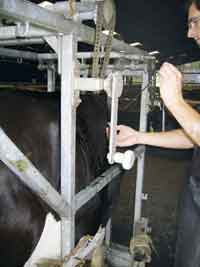Liver biopsies can help avoid copper toxicity in cows

Copper may be an essential trace element for fertility and overall performance, but producers should “do the maths” when it comes to total levels in winter rations, as over supplementation could have extreme consequences.
More often that not, the worst that can happen with over-supplementation is you waste your money, but with copper you can actually do significant harm, explains vet Ben Brearley, The Livestock Partnership..
“In cattle, excess copper is stored primarily in the liver. As maximum storage capacity is reached, stress through calving or disease can cause release of large amounts of the mineral into the blood.” This can result in cow losses, with death often being the only clinical sign of copper toxicity.
Vet Phil McIntosh, Westpoint Vets, has carried out liver biopsies on seven farms this year, all of which have come back with above ideal copper levels.
“Six out of the seven farms were not showing any clinical signs of copper toxicity, but had copper levels of about 15,000 micromol/kg/DM – this is above the acceptable range of 300-8000 micromol/kg/DM.”
And the farm experiencing clinical signs had severe copper toxicity of 20,000 micromol/kg/DM.
“Routine liver testing can be extremely useful in picking up potential mineral toxicity before clinical signs are seen – this means copper levels in the ration can be lowered accordingly,” he says.
Mr McIntosh would recommend annually testing a sample of cows as routine as well as testing as a result of clinical signs of toxicity.
“Considering you could lose a cow worth about £2000 as a result of copper toxicity, the cost of liver biopsy, at about £300 for five samples plus vet costs, is well worth it.” This cost will also include analysis of other key minerals and will help identify mineral deficiencies, allowing formulation of herd specific, bespoke minerals.
When it comes to minerals, the idea that some is good, but more is better is not always true, continues Richard Vecqueray, Evidence Based Vet Consultancy.
“The safe and legal limit for copper is 38mg/kg/DM a cow a day or a total of 800mg a cow a day.”
Most farmers will supplement 20mg/kg/DM a cow a day up to this level, depending on background levels of molybdenum, sulphur and iron, which must be determined through forage mineral analysis.
“Accidents can happen when producers only count copper in mineral bags and ignore levels in distillery products – which are particularly high in the mineral, and in parlour concentrates.
“It is essential you look at total copper levels in the diet – potentially copper could be in four or five different sources, be it minerals, by-products, forage, boluses or cake.”
But assessing the type of copper present is also important. “One or two sources could be in organic or chelated forms which are a lot more available to the cow.”
Although these “added value” products are useful, when deciding to use them, it is essential to do the maths and use with extreme caution, Mr Vecqueray stresses.
A lot of high input/high output dairy herds are receiving a lot of supplementation , but is essential to have a balanced overview of total trace element levels in the diet, agrees Jonathan Statham, Bishopton Vet Group.
“As well as copper, selenium toxicity can also result in cow deaths, coupled with added food safety issues.
“It is important to have good communication between all involved in supplying feed and minerals on farm so that mineral levels are not exceeded.”
